2016/06/17 by Joshua Harris
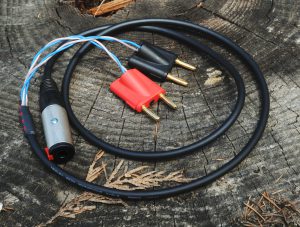
Here is a quick little project that I pulled together so we could see just how power hungry headphones (like Hifi Men and their ilk) sound on our lovely sounding directly heated triode amplifiers. With the DC filaments on the StereomourII, the results were quite nice. The parts I used are all available from a variety of online vendors.
I wasn’t taking notes or pictures when I put this together, but this is an easy enough project to put together once you see the parts for yourself.
First order up the parts. I used these part numbers, but you could use any quad microphone cable you like, different connectors, et cetera. Markertek sells all of these exact model numbers; other vendors may or may not carry all three.
• Rean NYS508-R NYS508-B dual banana plugs (one of each, about $2 each)
• Neutrik NJ3FC6 cable mount TRS jack (one, about $7)
• Mogami W2534 (about $1.30 per foot, purchase to desired length (I used about 3 feet))
Strip the outer jacket and shielding (braided copper if the Mogami is used) off each end. I did about 7″ (178mm) on one end, which is long enough for the ends to reach the binding posts on a Kaiju. The other end I stripped as needed by the plug, so it may vary.
Disassemble the TRS jack. The one shown has a screw as well as the screwed on strain relief. Slide the strain relief and connector body over the short stripped end.
Strip the blue and clear wires on the short stripped end about ¼” (7mm). Solder one blue wire to the tip lug, and the other to the ring lug. Solder both clear wires to the sleeve lug.
Strip the blue and clear wires on the long stripped end about ½” (14mm). Use the continuity checker on your meter to determine which blue wire is on the right channel (ring terminal). Mark that pair with tape. Confirm continuity on the left channel (tip terminal) and grounds while you’re at it.
Reassemble the TRS jack. Feel good that you don’t have anything on the other end of the cable when you realize you left a piece off…
Disassemble the banana plugs. The ones shown are held together with a black screw in the plastic body. Once the body is apart, you insert a small flathead screwdriver into the individual bananas to loosen a setscrew that will secure the wire in a small hole. I found the fit to be better if the end is folded over on itself before inserting. Take the pair of wires marked as belonging to the right channel and insert the blue wire into one post and the clear wire into the other, securing with the setscrews. Assemble the red banana plug around these connections. Mark the blue wire with a “+” and the clear wire with a “-” on the outside of the the plug. Repeat for the left channel. I recommend using the same positions for the + and – bananas as used on the right channel, since the black plastic is hard to mark.
That’s it. Of course, you could use whatever cable dressing you like (tech flex, cable pants, heat shrink, et cetera), but that’s all you need to do to make a functional cable.
IMPORTANT NOTES:
1) There is no protection of the headphones provided as built. Use this adapter at your own risk. Headphones can easily be damaged by a strong signal; do not hot swap interconnects with headphones on your output! Use of this kind of device with high powered amps is not recommended.
2) We do not recommend this for AC heated SET amps.
3) Directly heated triodes are a microphonic; you will hear some ringing when you touch the amplifier or the surface it rests on.
4) You certainly can use this with low impedance, high efficiency headphones. You will hear some tube rush and other noise. Wire your output transformers to the lowest impedance for the best signal-to-noise ratio.
5) Most important! This project is presented as a DIY solution to a problem.
That means •Do •It •Yourself!.
There is no technical support offered for this project. There is no advice offered for this project. There is no recourse if you screw it up (see note 1).
It costs about $15 dollars to do this project with the pieces suggested. You could probably get that down to just over $5 if you use cheaper parts and a short cable. Time investment is minimal as well. If you want to know how it works, TRY IT. This project is far simpler than any kit we offer, or ever will offer. It would make a great warmup project for a first timer, or just a useful thing to have around an audio house.
2015/07/10 by Doc B.
It’s a little hard to discern when you look at the Bottlehead Products web page, but there is a sort of logic to the various choices in each product category. We have, more or less, four levels of gear.
Entry Level
The entry level includes the Quickie battery powered tube preamp, the Quicksand battery powered solid state amp, and the Fix baffle step corrector and treble compensator for small monitors. These are all very easy to build kits that are assembled on acrylic panels. Since they are battery powered they can make a great off-the-grid setup for a vacation cabin or maybe that killer system you have always wanted to attach to your Burning Man moving sculpture. Don’t let the low prices fool you, this is a legit setup with high fidelity. Could make a killer setup with some of Andrew Jones’ amazing budget speakers (the Pioneer or the ELAC versions), your own homebrew mini monitors, or your favorite headphones.
For an entry level dedicated headphone amp that takes up less space than the system above we have the Crack output-transformer-less tube amp (OTL), designed specifically for high impedance headphones. OTL means we don’t need to include an output transformer in the design and hence the price can be lower than typical with-output-transformer designs. Use the Crack amp with high impedance cans like Sennheiser HD580/600/650 and Beyerdynamic DT880s and hear what everyone has been raving about.
Mid Level
The mid level of kits includes the Reduction tube phono preamp, the Smash tube preamp, the Seductor stereo tube amplifier. These kits are AC mains powered and thus have power transformers and laser cut aluminum chassis panels that sit on alder bases.
Reduction is designed to work well with moving magnet phono cartridges in the 5mV and higher output range, or moving coil cartridges with a suitable step up transformer. It will work very well with the Smash/Seductor combo.
Smash has three inputs and can be upgraded with our most excellent sounding stepped attenuator upgrade called SmashQuiet. And Smash has two outputs that allow you to connect a subwoofer amp at line level. Seductor has about about 4wpc. Smash/Seductor would be killer with some mid priced high fidelity speakers like Blumenstein Orcas (try using Fix with this setup, yum).
For high impedance headphone use only the new Crackatwoa amp offers a step up in sophistication from our best selling Crack OTL amp. If you have a killer pair of high impedance cans and want to up their game, go Crackatwoa.
Premium Level
The premium levels tube audio kits include The Eros phono and tape head preamps, BeePre preamp, the Kaiju 300B stereo/monoblock convertible amp, the StereomourII integrated 2A3 amp, and the Mainline headphone amp. For purists we also offer the Submissive passive controller. These kits are a little more involved to build than the mid level kits due to the greater sophistication of the design.
Eros phono is designed to work well with moving magnet and high output moving coil cartridges and works wonderfully with low output moving coil cartridges with a suitable step up transformer. Eros tape head is designed to work with typical prosumer type playback heads such as those used in Technics, Otari, Tascam, etc. decks that have been rewired for direct head output. Both of these low level preamps work very well with the BeePre/300B amp combo, StereomourII and Mainline.
What does the BeePre/Kaiju combo get you that StereomourII doesn’t? BeePre puts directly 300B heated tubes in the preamp stage and offers shunt voltage regulation, which in our experience contribute to the highest level of resolution. StereomourII uses the venerable 12AT7 tube for the preamp section and a less complex power supply. BeePre is also capable of being set up for XLR balanced inputs. And BeePre has two sets of output jacks and can be configured for XLR output. Kaiju has twice the power of Stereomour at 8wpc vs. 4wpc. Kaiju will also be capable of being strapped into a monoblock amp so that you can employ two Kaijus as 16wpc monoblocks for driving less efficient speakers. The BeePre/Kaiju combo can be configured with all DC powered filaments for a super low signal to noise level that works well with high efficiency horn speakers, as can StereomourII. StereomourII holds the distinct advantage of being much smaller than the BeePre/Kaiju combo if space is critical, while retaining a major fraction of the musical goods that BeePre/Kaiju deliver. These setups will work great with big horns, efficient open baffle setups and multi-way/multi-amp setups (Doc’s favorite kind of speaker setup, BTW).
And what does Mainline do that Crack and Crackatwoa don’t? Mainline works with headphone of any impedance, and it has the highest resolution of the three amps. Part of this is due to the very linear single gain stage design and more sophisticated power supply. The other major factor is the employment of our unique coarse/fine stepped attenuator as offered in the BeePre, StereomourII and Smash kits. It is capable of running balanced headphone cables and will work with all but the most inefficient headphones (which we recommend the more powerful S.E.X. amp for). This amp is a great combo with premium headphones like HD800s, LCD-2s and T-1s.
Custom Level
This level includes our Tube Repro tape head preamp, Tube Phono phono preamp and Neothoriator headphone amp. These finished products are built for you by our technicians and offer the highest level of sophistication and parts quality. Our premium level kit products will work very well with these finished products.
But can I mix and match?
Absolutely! You can sub a BeePre in for a Smash to use with a Seductor, and going the other way you could even use a Quickie with a Kaiju! However there are some guidelines to keep in mind.
The Eros phono preamp has more gain than the Reduction phono preamp and might work better with lower output phono cartridges.
Because of their clean and unencumbered design Eros and Reduction both have fairly high output impedance and thus the relatively low input impedance of the Submissive passive control might not work as well with those phono preamps as it would with a digital source that has a low impedance opamp output.
The Smash preamp has more gain than Quickie or BeePre and might get a little touchy if used ahead of, say, a really sensitive solid state amp rather than one of our products.
Also bear in mind that as the price level goes up, so goes up the power level of the power amps. One more general guideline is that kits within a specific level tend to share a lot of technology and thus sonic “equality”. Incorporating a kit from the next level down with kits from a level or two up might sacrifice a hair of resolution. The sound won’t be ruined by any stretch of the imagination, but you might not be getting every last ounce of performance the more sophisticated kits can deliver.
2014/09/01 by Joshua Harris
First, buy the necessary supplies:
2 x CMLI-15/15B (CMLI-15/15B2 will also work) transformers, ordered from www.cinemag.biz. Be sure to order as a single 3/8″ stud
From www.mouser.com:
2 x 22KΩ 1/4W resistors (Mouser 660-MF1/4DC2202F)
2 x Neutrik female XLR jacks (Mouser 568-NC3FD-L-1)
1 x 5-lug terminal strip (Mouser 158-1005)
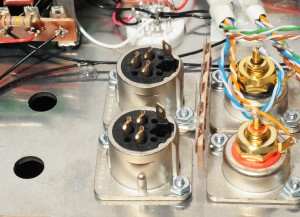
Remove the plastic hole covers. Trim the wires off the RCA Jacks closest to the transformer holes. Mount the XLR jacks with the existing hardware and add a 5-lug terminal strip to the back hole of the front XLR jack. The terminals are numbered from front-to-back.
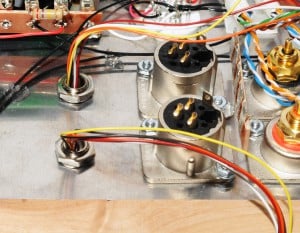
Mount the transformers using the hardware supplied with the transformer — insert the post from the top side of the chassis and secure below with the lockwasher and nut. Do not fully tighten the transformers.
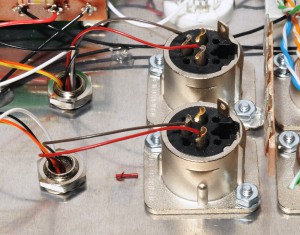
Attach and solder the red wires to pin 2 of the closest XLR jack.
Attach and solder the brown wires to pin 3 of the closest XLR jack.
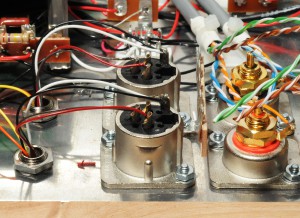
Attach and solder the black and white wires to the ground tab of the closest XLR jack.
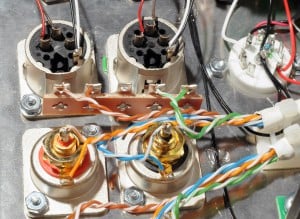
Attach the green solid wire to 1U, the green striped wire to 2U, the brown solid wire to 4U and the brown stripe wire to 5U. Do not solder any of these terminals.
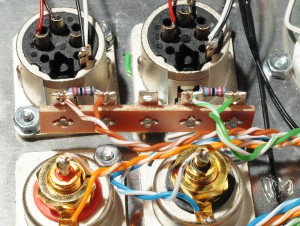
Attach a 22KΩ 1/4W resistor between 1U and 2U. Do not solder.
Attach a 22KΩ 1/4W resistor between 4U and 5U. Do not solder.
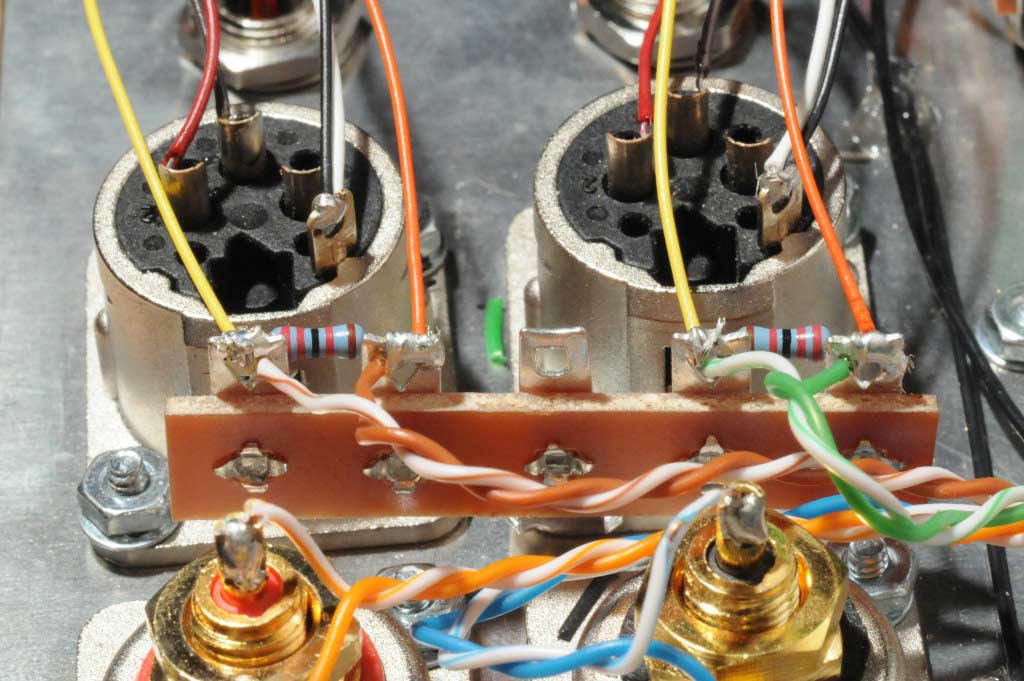
Attach and solder the orange wires to 1U and 4U. Attach and solder the yellow wires to 2U and 5U.
Return the BeePre to your system and power the system on. Switch the selector to the position for the balanced input and listen for hum. Rotate the transformers to minimize hum.
Enjoy your balanced input!
2014/01/16 by Doc B.
We’ve been talking about doing a blog for years but it took our recent web site overhaul to get us off dead center. The plan is to use the Bottlehead blog as a place to share some of the philosophy behind why we do this audio kit thing and some of the thought process involved in development of the products we offer.
It seems appropriate for this new soapbox to start with the cast of characters. We’ll get the old timer out of the way first.
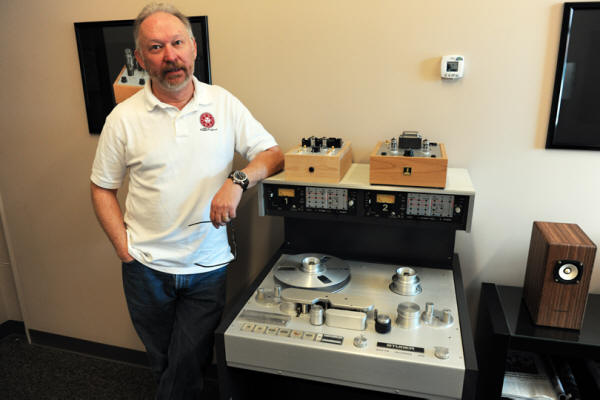
-photo by David Robinson
I’m the President For Life of Bottlehead Corporation. A DIY kinda guy since childhood when I would routinely take things apart to learn how they worked, and not nearly as often be able to put them back together. I got a degree in Physics at UC Berkeley a long time ago (way back even before Bosons were discovered). During the Reagan era the job market upon leaving college was such that it was easy to get employment as long as you were willing to work on stuff that killed people.
So I chose what seemed a logical alternative at the time and became a pastry chef. Stints with various small and medium sized food businesses, seasoned with the gritty reality of occasional work in multinational corporations here and there made me realize a couple of things. One was that I would not last long in the corporate world where my defective personality led to shooting off of mouth which often as not led to severance. The other was that with enough naiveté and a willingness to go long stretches with little money I could enjoy all the privileges of self employment.
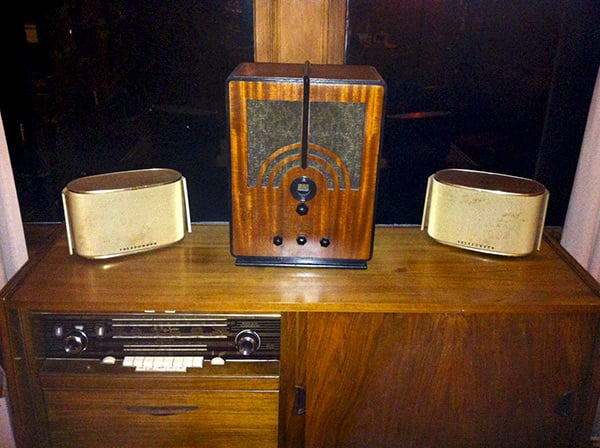
-remnants of my radio collecting days, a 1934 Philco tombstone radio atop a 1956 Telefuken Salzburg console
While the germ of self employment was fermenting like Red Star Yeast in a bowl on top of the fridge my fascination with audio seemed to focus on vacuum tubes. This was initiated by my playing with the push-pull 6BQ5 amp pulled from my dad’s old Magnavox console. One fateful day of dumpster diving at a local Value Village yielded the tipping point – a 1950’s vintage Telefunken Gavotte vacuum tube table radio. With that acquisition began a rather crazed period of the acquisition of many more antique radios, which eventually turned into a gig restoring radios for others. A repeating theme in my life has been the ruination of perfectly good hobbies by turning them into a business. In the end that business (called Classic Radio Of Liberty Bay) turned out to be a lot of work for too little money, but during its development I would pick also up various pieces of Golden Age tube audio gear to play with along with old radios, thus setting the stage for the next act.
I kept running across the same wacky group of local guys who would be competing with me to snag the latest Dynaco or McIntosh or Eico amp to be unearthed in the Seattle area. And so I decided test the waters of this newly found vintage audio collector’s craze by forming a club for these like minded loonies. From that club emerged VALVE, a paper newsletter (this was back in the final days of photocopy machines and real paper newsletters arriving in the mail) for Vintage Audio Listeners and Valve Enthusiasts. Looking back, I see VALVE as a monument to my lack of knowledge on the subject. But it seems to be an entertaining read for DIY audio types and we have a VALVE newsletter archive in the Bottlehead Forum database.
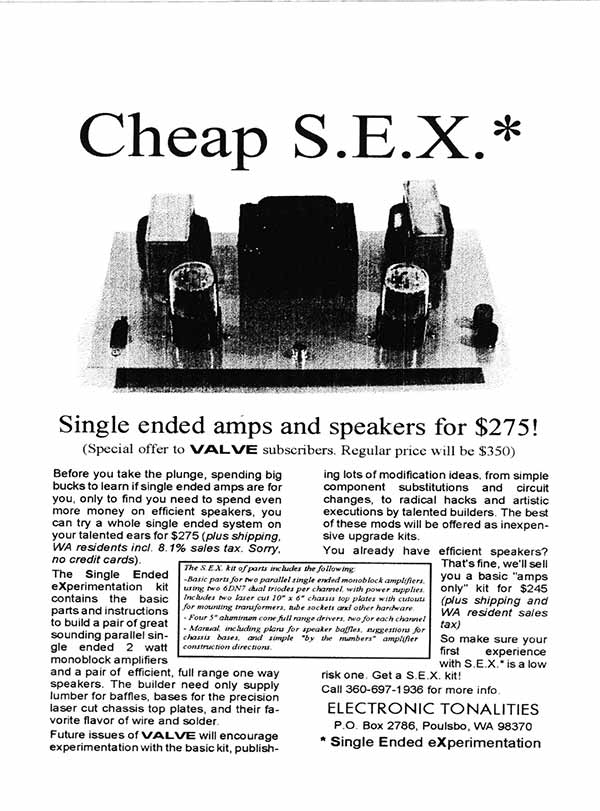
–an ad for the original S.E.X. kit
The next stage in propulsion to the apex of vacuum tube dabbling occurred at one of the local VALVE club meetings. My earliest acquaintance in the local vintage audio scene was Dave Dintenfass. Dave brought to a VALVE meeting the hand drawn schematic and some parts to make a tube amplifier from a single tube per channel, a “one tuber”, nomenclature which eventually evolved into what is referred to these days as a spud amp. The idea still holds merit; check out our Mainline headphone amp for a prime example.
The parts Dave brought combined with others from my rather out of control parts stash came together into a listenable circuit in about 45 minutes. Another newly found friend, Paul Joppa, worked with me to put together a single driver speaker mounted in a heavy cardboard box that housed a recent kitchen sink purchase – thusly named the everything-but-the-kitchen-sink-speaker. Hooking this hasty pudding together resulted in about a dozen dropped jaws. There was a natural skin tone, a realistic texture, a lifelike appearance and a warm tingle from this single ended amplified single driver lash up that had everyone looking at each other, shrugging shoulders and scratching balding heads.
I couldn’t shake this experience and decided to cook up a kit for the local gang to try this concept out. Called the Single Ended eXperimenter’s kit (S.E.X.), the pair of monoblocks cost $275 and even included the metal cone drivers that had been used at the meet. Word seemed to travel quickly and thus in early 1994 began a backlog on kit orders that continues to this day. More kits came soon thereafter including the best selling Foreplay preamp, a design inspired by George Wright. George named the preamp – “What comes before S.E.X.? Foreplay!” Afterglow, B-Glow, Straight 8 speakers, etc, followed over the next few years. Paul Joppa retired from his career in acoustics at Boeing and became the head designer for Bottlehead. Working closely together PJ and I cooked up kits like Paramour, Seduction and Foreplay 2 and 3, and that working relationship continues to bear fruit like Paramount and Eros, and nowadays with the help of another Paul (Birkeland, aka PB), unique and exceptional products like BeePre and Mainline.
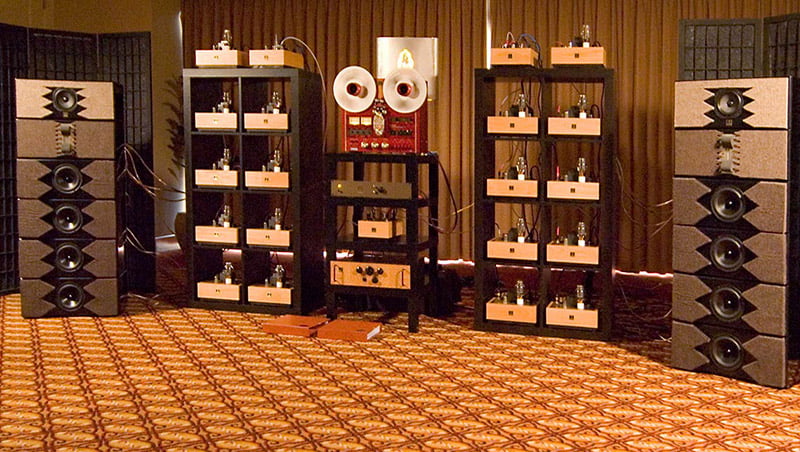
-the Bottlehead room at VSAC 2008
About the same time as the kits took off a new thing called the Web started up. A great slippery wiggling handful, the Web made us learn how little we knew about civility and how tricky “type now, think later” communication can be. Along with the steep learning curve of the Web came an amazing access to the sharing of ideas and a truly easy way for a small group of individuals with like interests who might be spread around the globe to interact. And thus at some point about 1996 we went from being known to 600 people to being known to 6000 people, quite literally overnight. The trend continues to this day, we had over 6.4 million page views of the Bottlehead Forum in 2013.
In spite of the Web, face to face meeting was how a few million years of evolution designed us to interact most effectively. Queen Eileen and I discussed the idea of trying to get all these interesting individuals we had communicated with under one roof for a few days and the Vacuum State of the Art Conference was born in 1997. While it had some aspects of a trade show in that manufacturers of gear who fit into the whole “Ultra Fi” tube amp and efficient speaker philosophy showed their setups, it was primarily a bigass party at which hobbyists and manufacturers could approach each other and share ideas. DIYers got equal time with pros, we even had a room for them to demo their creations, called the Craftsman’s Room. And an equal number of hardcore DIYers and industry types shared the podium in the seminars.
We did four of those, 97,98,01,03 and we licensed the event to someone in 2008. Will there be more? Not sure, but the question certainly comes up every year. They really were fun, and you just don’t get the same vibe at any of the plethora of regional trade shows around the world these days. Meantime, being one who is always looking for something new and different, I started down another road in this wacky audio biz.
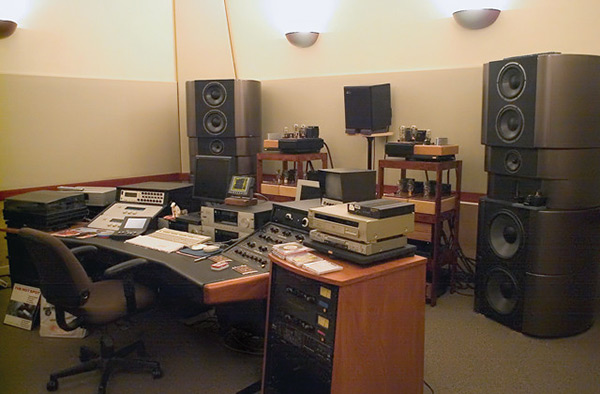
–the Camellia Room, at 1340 Mission
I had made friends with Grammy winning mastering engineer Paul Stubblebine (aka PS, I know a lot of Pauls!) and his business partner at the time, Michael Romanowski in about 1997. After VSAC 2003 Paul invited me to listen to some speakers he was considering for a new mastering room, made by a fledgling company called Magico. After the session I was asked if I would be interested in doing the electronics for the complex four way system – an individual tube amp for each driver and an all tube electronic four way crossover. Duh, hell yes! And thus began my association with Paul, Michael and the facility known as 1340 Mission in San Francisco.
The project was rather involved and one of the critical lessons I learned in working with Paul is that a good room takes about two to three years to dial in. During the many listening and evaluation sessions that occurred in that time period we found that we tended to gravitate to Paul’s 1” two track tape deck as our source, playing material he had in his extensive library. Thus my love of the sound of tape began.
The Tape Project was born out of those listening sessions and thus I acquired my second job as one of the three managing directors of TP. With 24 titles released as of this writing TP has lead the way in a small but significant revival of albums recorded to high quality reel to reel tape. As the gear guy, I learned everything I could about tape as fast as possible and we developed both playback electronics like the Tube Repro and Eros tape head preamp, as well as mechanical upgrades to two of the more popular prosumer tape decks. As reviews declaring TP tapes the best sounding format available began to appear Bottlehead was invited to incorporate our gear into some Best Sound of Show winning rooms at the likes of CES and RMAF. It seemed that after 15 years of hard work trying to convince people that investing the time into building innovative designs was a better choice than buying and flipping a different Stereophile A list box with a half inch think aluminum faceplate every three months, Bottlehead became an overnight sensation.
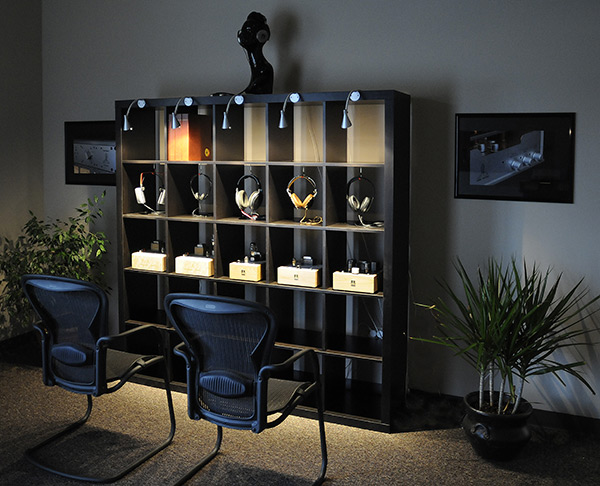
–a headphone demo installation at Bottleheadquarters
So what next? In the early 2000s it was apparent to me that high end headphones would be a big thing very soon as the “headphone generation” who grew up listening to iPods headed to college and early careers. Unfortunately we were so busy with other projects that we didn’t get a tube headphone amp kit out for several more years. And when we finally did one it was by done creating a headphone output option to the latest version of our old friend the S.E.X. amp. It soon became clear that a dedicated headphone amp was something our customers wanted, and PB pitched an OTL headphone amp idea as his first design contribution to the Bottlehead line. Thus we came out with Crack, currently our biggest selling kit. The market seems insatiable and we continue to develop new designs like Mainline to work with the continually evolving high end headphone market.
Another direction that I have wanted to go for years was in the musical instrument and recording end of the business. The most obvious first step into this realm was a guitar amp. The resulting Tode was my first step back as lead designer in many years, and I have to say it was fun to be back scribbling notes, cutting wire and soldering components. Watch for increased exposure of Tode in the coming months along with some other music and recording related kits.
Well enough about me, how was your day?
Doc B.
Bottleheadquarters • 26272 Twelve Trees Lane NW, Suite D Poulsbo WA 98370 • 206-451-4275
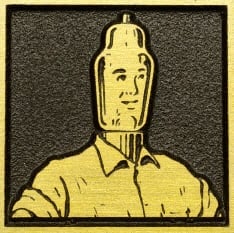
©Bottlehead 2024. All rights reserved